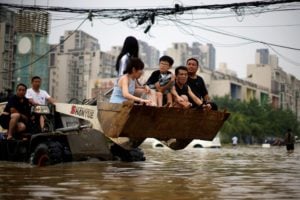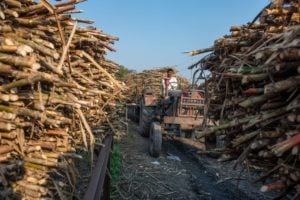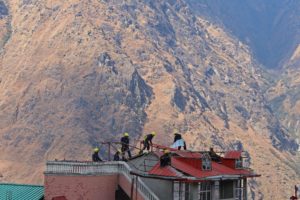“It was getting hotter and hotter.”
So starts The Ministry for the Future by Kim Stanley Robinson. Unlike the American science fiction writer’s other work, which is usually set in the distant future, this novel, published in 2020, is set in 2025 and describes the realistic consequences of climate change many people are already experiencing, such as intense and prolonged heatwaves, floods and political chaos.
The most recent scenarios put forward by the Intergovernmental Panel on Climate Change (IPCC) indicate that it is increasingly likely that the earth’s temperature will rise by more than 1.5C above pre-industrial levels.
What is geoengineering?
Also called climate engineering, it is a set of techniques designed to modify the climate in order to alleviate global warming.
The urgency of the climate crisis has sparked debate among scientists and governments on methods to curb this rise. This is where geoengineering comes in, a term that encompasses all techniques designed to modify the climate and alleviate the effects of global warming, according to the IPCC glossary.
The scientific community divides geoengineering into two broad categories: removing greenhouse gases, specifically carbon dioxide, from the atmosphere, and solar radiation modification. These include a variety of techniques, from painting a rooftop white to reflect the sun’s rays to injecting aerosols into the stratosphere.
“As we approach a 2C [increase in] global temperature, many believe that geoengineering becomes a possibility to manage some of the risks of global warming. The debate has completely shifted from not being on the agenda to being essentially everywhere,” says Janos Pasztor, executive director of the Carnegie Climate Governance Initiative (C2G).
Latin America is one of the least developed regions in this field. Few projects exist, and many of them pursue commercial interests rather than the climate agenda. However, given the potentially far-reaching consequences of geoengineering, research is needed to understand the impact of these interventions.
“If we don’t have clear rules, anyone could do whatever they want. It’s a debate that should involve everyone,” Pasztor adds.
Carbon dioxide removal
According to the Geoengineering Map, a civil-society initiative that tracks projects, there are currently 764 active geoengineering projects worldwide. Most are concentrated in the United States, Europe and China. Latin America has only 22 across seven countries and territories: Brazil, Argentina, Mexico, Chile, Jamaica, Puerto Rico and the Dominican Republic. Half of these are dedicated to the removal of greenhouse gases, such as carbon dioxide (CO2), from the atmosphere.
Some are based on natural processes, such as planting forests. Others are mixed processes, such as bioenergy with carbon capture and storage, which grows plants for fuel and then captures the CO2 generated when this biomass is converted into energy. Others are purely technological, such as carbon capture and storage, which involves chemically extracting and locking away CO2 at the source of emission before it enters the atmosphere. 
All are controversial in one sense or another. Removing CO2 from the atmosphere on the scale needed is expensive, energy- and resource-intensive. Moreover, its application is logistically difficult.
According to Inés Camilloni, a professor in the Department of Atmospheric and Oceanic Sciences at the University of Buenos Aires and a researcher at the Argentina National Research Council (CONICET), there are no large-scale geoengineering projects in Latin America. “There are more localised techniques, short-range and without any global impact,” she says.
Geoengineering projects in Latin America are more localised techniques, short-range and without any global impact
Most projects are low-impact private initiatives: they remove CO2 from one or two industries. One example is the agreement between Air Liquide and Coca-Cola Femsa in Brazil. Since 2012, the former has supplied captured and stored CO2 to carbonate the soft drinks produced by the latter, but there is no public record of the volumes involved.
There are also some larger-scale projects linked to governments and national or foreign companies, such as Highly Innovative Fuels Global. Since 2016, HIF Global has been developing e-fuels, which use electricity from renewable energy sources and captured CO2 to produce fuels that are climate neutral. It has plants in Chile.
Reflecting the sun
Managing solar radiation, the other main geoengineering approach, is complex, says Camilloni, whose work is focused on solar radiation modification. “It is one of the most comprehensive and most dangerous techniques,” she cautions. Camilloni explains that the main objective is to reflect the sun’s rays away from the earth, but these techniques are even less developed than carbon removal.
“The most basic [technique] is to paint surfaces white, which has no global impacts. There are several terrestrial options, such as covering ice with sheeting, and space-based ones, such as installing mirrors high in the atmosphere and stratospheric aerosol injection [SAI], the most dangerous of all which is also the most suitable technique for achieving a global effect,” she says.

This effect was demonstrated when Mount Pinatubo in the Philippines erupted in June 1991. More than a decade later, in 2005, John Church, at the time a researcher at the centre for Marine and Atmospheric Research of Australia’s Commonwealth Scientific and Industrial Research Organisation (CSIRO), showed that the eruption had briefly halted atmospheric and oceanic warming. Ash and gas ejected by the volcano formed a gigantic, worldwide smokescreen of aerosols high up in the atmosphere that reflected large amounts of sunlight away from the surface of the earth.
According to Andy Parker, chief executive of the Degrees Initiative, a London-based organisation dedicated to promoting research into the effects of solar radiation modification in the global south, SAI can be really useful. “It’s the only known way to halt or quickly reverse the rise in global temperatures if we don’t reduce our global greenhouse gas emissions,” he says.
“But these methods can also be very dangerous. We don’t entirely know the effects of implementing this kind of technology. There may be things out there that scientists have not yet discovered. We do know that if we do it in an unrestrained or irregular way it can alter weather patterns,” Parker adds.
Parker refers to the significant side effects solar radiation modification could bring, such as acid rain, depletion of the ozone layer or changes in weather patterns.
In Latin America, the Degrees Initiative has funded two research projects measuring the possible effects of injecting aerosols into the stratosphere: one in Buenos Aires, led by Camilloni, and one in Jamaica, led by Leonardo Clarke, a lecturer in the physics department at the University of the West Indies.
“In the La Plata basin, our results indicate that there may be an increase in rainfall. What does this mean? If SAI is implemented in the world, Argentina will have to see what happens to the hydroelectric dams on the Paraná River and crops in the area,” Camilloni explains.
Clarke explains that, in Jamaica and the Caribbean, according to the data collected, “there would be an increase in rainfall in certain parts of the year, and more droughts in others”. Both scientists agree that this is the kind of research that is necessary into the rules that should govern solar geoengineering.
Tension between countries
C2G is currently working with governments and climate negotiating groups such as the G77 plus China to encourage discussion of the governance of geoengineering. However, few are to date ready to take a stand on the issue, Pasztor says.
“First, there is nothing concrete and, second, it is an issue that can create a lot of tension between countries that might implement this technology,” C2G’s executive director explains.

In Latin America, the organisation has already spoken to high-level officials in Argentina, Uruguay, Chile and Colombia, and is planning to visit Panama, Mexico, Costa Rica and Brazil this year.
“The environment ministries have assured us that there is serious concern about the risks of geoengineering,” Pasztor says.
So far, Mexico is the only country in the region that has made a public statement on geoengineering, at the beginning of the year. The ministry of the environment (Semarnat) and the National Council for Science and Technology (Conacyt) said they were against “experimentation with solar geoengineering” in the country and that they would implement a strategy to prohibit these practices within the national territory.
The statement came after Make Sunsets, a US climate start-up founded in October 2022, conducted an unauthorised experiment last year, sending balloons injected with sulphur dioxide particles into the atmosphere from the Mexican state of Baja California, which borders the US state of California. The Mexican government claims the experiment was conducted “without prior notice and without consent”.
C2G believes that the issue of geoengineering could come up at the COP28 climate change conference in the United Arab Emirates later this year. “We want the Latin American negotiating groups to hold all the cards,” says Pasztor, meaning that there’s a desire for them to be fully informed about the issue. This, he argues, could generate a deeper political debate in Latin America on the role of geoengineering.
In The Ministry for the Future, geoengineering was one of the main ways in which humanity mitigated global warming. However, that future came at a great cost — millions died and thousands became climate refugees. In the real world, greater research is sorely needed to avoid the dangers of which scientists warn.








